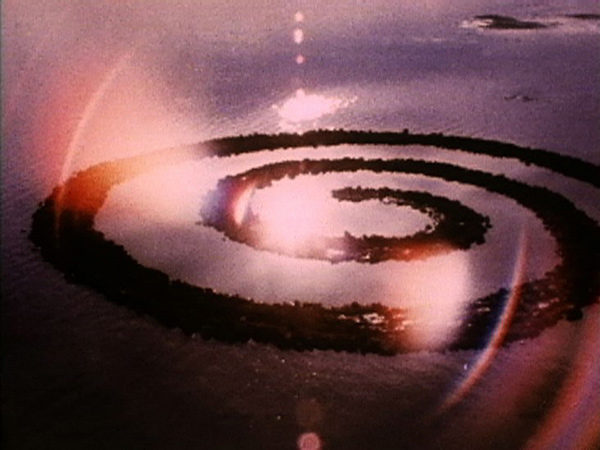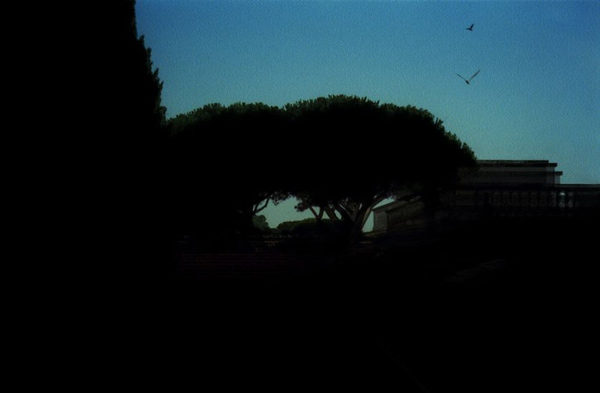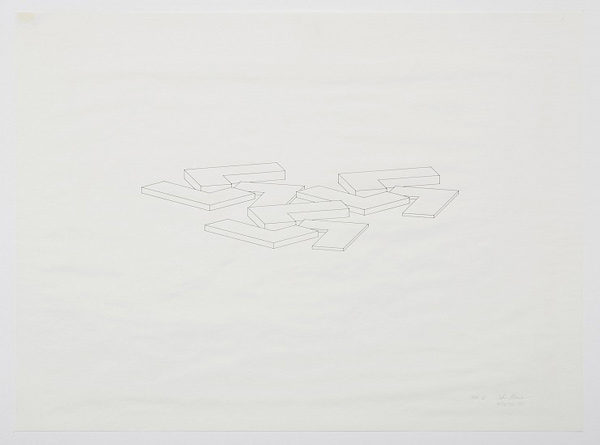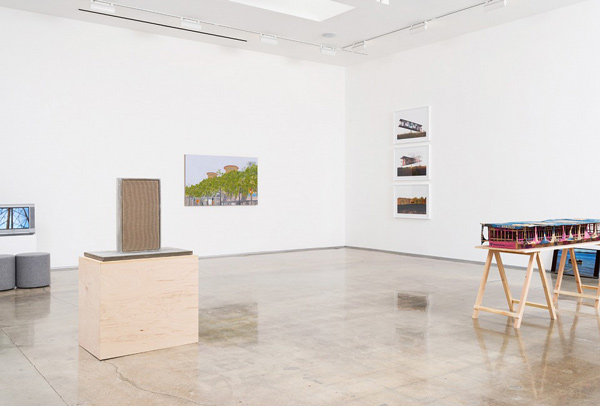Exploring the dialectic relationship between environments—both built and natural—and the figures that occupy those spaces, “Vernacular Environments, Part 1” brings to light the complexities and temporality of the vernacular. A film of Robert Smithson’s Spiral Jetty (1970) serves as the show’s departure point, illustrating the construction of Smithson’s earthwork as a conditional art relying on time and space for its existence, continually vanishing and resurfacing as the tide rises and falls.

Robert Smithson, Spiral Jetty (1970). Color Film. Courtesy of Edward Cella Art + Architecture.
In the main gallery, the visitor is received by Stephen Berens’ photo series “All days are nights” (2013) that upon first glance, seems to be nothing more than a collection of hazy snapshots taken from one vantage point. While that is true, each work is also a multilayered photograph of varying times and days of the same landscape, evidenced in the elusive overlapping of trees, clouds, and buildings. This subtle layering of images in Berens’ series shows the ephemeral nature of time, both in how we understand the concept of impermanence and the impact of time on the landscape itself.

Stephen Berens, July 31, 2005, Afternoon, July 19, 2005 Morning, August 8, 2005, Morning, July 29, 2005, Late Afternoon (2013). Dye-based inkjet print, 24 x 34 in. (61 x 86.4 cm). From the series All days are nights (2013-2014). Courtesy of the artist and Edward Cella Art + Architecture.
Adjacent to Berens’ photographs is Clarissa Tossin’s multimedia Monument to Sacolândia (2010), which takes a more critical approach. Comprised of an architectural model made of empty concrete bags, a video of the model placed in an artificial lake, and postcards of a still image from the video, the triad functions as representation and commentary on the president’s palace in Brazil’s new planned capital city, Brasília. Tossin combines elements from natural and man-made environments to address the myth and superficiality of a utopian vernacular. The artist’s upbringing in the capital city has shaped her relationship with architecture, adding an alternative and international perspective to the exhibition.

Clarissa Tossin, Monument to Sacolândia (2010). Single channel HD video, cement bag architectural model, postcards. Courtesy of the artist and Edward Cella Art + Architecture.
While some pieces accentuated the natural environment, others focused on the fabricated environment, including John Mason’s Hudson River Series (1978). A collection of 10 geometric and modular contour drawings of bricks with small-scale bricks arranged underneath, Mason’s self-evident forms—slightly reminiscent of Sol LeWitt’s minimalist sculptures— confirm the wide range of what exactly encompasses the vernacular. United by the interplay of man and environment, “Vernacular Environments, Part 1” suggests the manifold ways in which the artist can engage with and respond to their surroundings.

John Mason, Hudson River Series (1978). Graphite on vellum, 18 x 24 in. (45.7 x 61 cm). Courtesy of the artist and Edward Cella Art + Architecture.
“Vernacular Environments, Part 1,” May 20 – July 15, 2017 at Edward Cella Art + Architecture, 2754 S. La Cienega Blvd Los Angeles, CA 90034, edwardcella.com.



















0 Comments